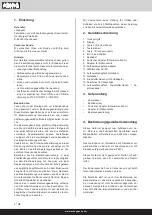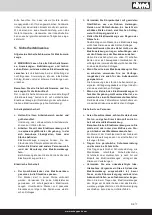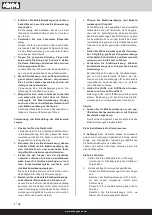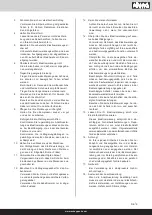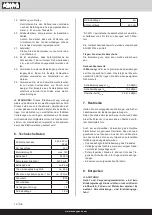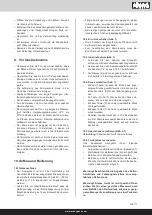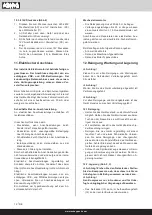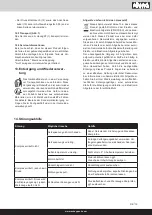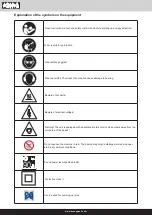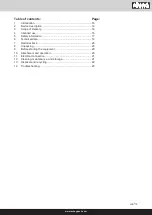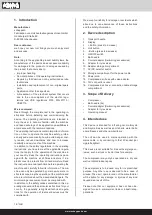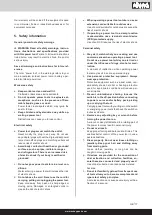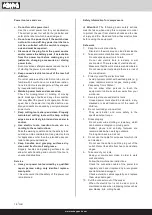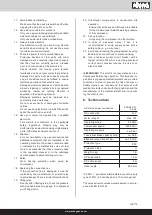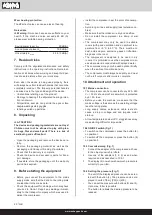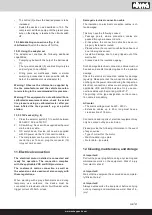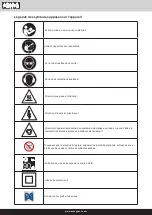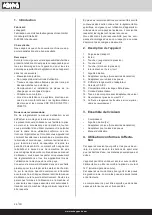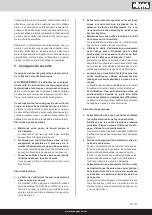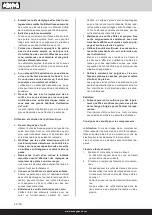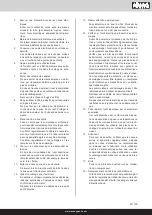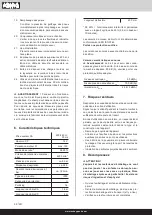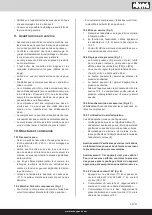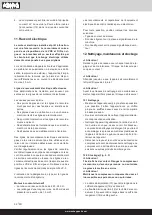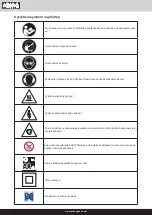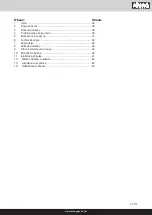
www.scheppach.com
20 | GB
• Install the compressor near the point of consump-
tion.
•
Avoid long air lines and supply lines (extension ca
-
bles).
•
Make sure that the intake air is dry and dustfree.
• Do not install the compressor in a damp or wet
room.
•
The compressor may only be used in suitable
rooms (with good ventilation and an ambient tem-
perature from +5 °C to 40 °C). There must be no
dust, acids, vapors, explosive gases or inflamma
-
ble gases in the room.
•
The compressor is designed to be used in dry
rooms. It is prohibited to use the compressor in ar-
eas where work is conducted with sprayed water.
•
The compressor may only be used outdoor briefly
when the ambient conditions are dry.
•
The compressor must always be kept dry and must
not be left outdoors after work is complete.
10. Attachment and operation
10.1 Mains connection
•
The compressor can be connected to any 220 - 240
V~ / 50 Hz shock-proof socket which is protected
by a 15 A fuse.
•
Before you use the machine, make sure that the
mains voltage is the same as the operating voltage
(see the rating plate).
•
Long supply cables, extensions, cable reels etc.
cause a drop in voltage and can impede motor
start-up.
•
At low temperatures below +5°C, sluggishness may
make starting difficult or impossible.
10.2 ON/OFF switch (fig. 1)
• To switch on the compressor, press the button (6)
on position I.
•
To switch off the compressor, press the button (6)
on position 0.
10.3 Commissioning (Fig. 1)
1.
Connect the adapter of the compressed air hose
to the object you wish to inflate.
2.
Use one of the adapters (7, 8, 9) as and when
required and as described in 10.5.1.
3.
The display (2) now shows how much pressure is
currently in your item.
10.4 Setting the pressure (Fig. 1)
•
The unit of the displayed pressure can be selec
-
ted with the button (4). The pressure can be dis-
played in units of [bar], [PSI] or [kPa].
•
You can set the pressure with buttons (3) and (5).
Up to max. 8 bar is possible.
•
The button (5) allows the desired pressure to be
reduced.
Wear hearing protection.
The effects of noise can cause a loss of hearing.
Noise data
m
Warning:
Noise can have serious effects on your
health. If the machine noise exceeds 85 dB (A),
please wear suitable hearing protection.
Sound power level
L
wA
90 dB(A)
Sound pressure level L
pA
75,9 dB(A)
Uncertainty
K
wA/pA
2,36 / 3 dB(A)
7. Residual risks
Comply with the stipulated maintenance and safety
instructions in the operating instructions. Remain at-
tentive at all times when working and keep third par-
ties at a safe distance from your work area.
Even when the device is being used properly, there
will always be certain residual hazards that cannot be
completely ruled out. The following potential hazards
can arise due to the type and design of the device:
•
Unintentional starting up of the product.
• Damage to hearing if the stipulated hearing protec-
tion is not worn.
•
Dirt particles, dust etc. can get into the eyes or face
despite wearing safety goggles.
• Inhaling swirled up particles.
8. Unpacking
m
ATTENTION!
The device and packaging materials are not toys!
Children must not be allowed to play with plas-
tic bags, film and small parts! There is a risk of
swallowing and suffocation!
• Open the packaging and remove the device care-
fully.
• Remove the packaging material as well as the
packaging and transport bracing (if available).
•
Check that the delivery is complete.
•
Check the device and accessory parts for trans
-
port damage.
•
If possible, store the packaging until the warranty
period has expired.
9.
Before starting the equipment
•
Before you connect the equipment to the mains
supply make sure that the data on the rating plate
are identical to the mains data.
•
Check the equipment for damage which may have
occurred in transit. Report any damage immedi
-
ately to the transport company which was used to
deliver the compressor.

